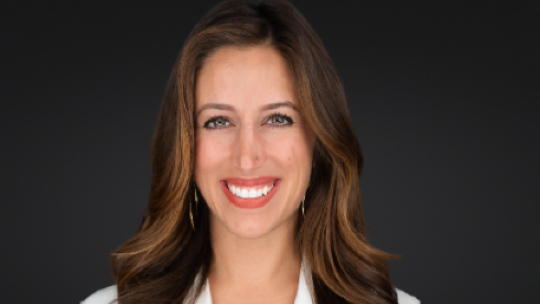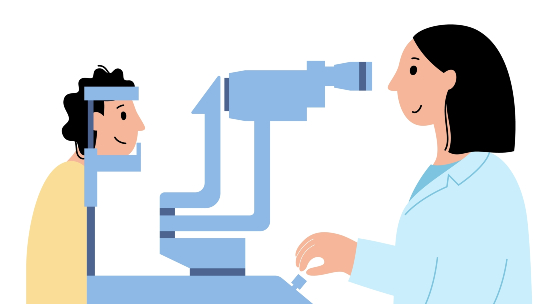My mom was 73 when her optometrist, James Miyasaka, O.D., diagnosed her with cataracts at her annual checkup. She was surprised. Since cataracts develop slowly and without pain, she only thought her glasses prescription might need changing.
My mom isn’t alone. While there are congenital cataracts, which are cataracts that form during birth through childhood, and traumatic cataracts, which you can get from an injury to the eye, age is the number one cause. According to the Cleveland Clinic, nearly 1 in 5 Americans ages 65 to 74 have cataracts that affect their vision, and more than half of people over 80 have cataracts or had surgery to remove it.
“If you live long enough, you’ll get cataracts,” says ophthalmologist Neda Nikpoor, M.D., who conducted my mom’s cataract’s surgery at Jenkins Eye Care. “In general, it’s eventual that everybody is going to get cataracts, and then we treat them when they do.”

Dr. Nida Nikpoor
What are cataracts?
Cataracts occur when the eye’s natural lens clouds, interfering with light passing through the retina, like looking through a dusty window. Cataracts symptoms may include:
- Blurred, distorted, or hazy vision.
- Images appearing dull or washed out.
- Double vision.
- Seeing glare around lights at night.
- Small print becoming difficult to read.
Cataracts are a normal part of aging. As we get older,the natural lens in the eye becomes cloudy, making it harder to see. Cataracts are a gradually progressing disease and usually occur in both eyes, though sometimes it may be worse in one eye, causing a difference in vision.
How are cataracts treated?
While lifestyle changes like wearing sunglasses, quitting smoking, limiting alcohol, and eating a healthy diet can possibly slow progression of cataracts, there is no foolproof prevention.
“Cataracts can only be treated with surgery,” says Dr. Nikpoor, who’s often asked if there are alternative treatments to restoring vision. “People are always asking if they can use eye drops to cure their cataracts, and so far, that does not exist.”
Even though cataracts are the leading cause of treatable blindness in the world, cataract surgery can help sight become restored completely.
When should you get cataract surgery?
Cataracts affect everyday life in varying degrees. For my mom, the impact was initially subtle. She could still drive and read books, but eventually began to notice the occasional light glares at night.
After about a year after her diagnosis, she found she couldn’t get her eyeglasses prescription quite right – the prescription was still blurry after several fittings. Signs on the road became slightly more difficult to see. That’s when she scheduled her surgery with Dr. Nikpoor, at the recommendation of her optometrist.
While you can have cataracts removed at any time, Dr. Nikpoor recommends getting cataract surgery as soon as it affects your activities in daily living.
“Some people think they have to wait until their vision is really bad, like failing a driver’s test, before we do surgery – but that’s not the case,” she says.

What does cataract surgery entail?
Cataract surgery is one of the most common and successful surgeries done in the U.S., with 3.7 million procedures performed each year.
“Cataract surgery is very safe, very effective, and very fast for most people,” says Dr. Nikpoor. “It’s about a 10- to 15-minute surgery, where we move the cloudy lens in the eye and replace it with the artificial lens implant. The implant allows more light to get in the eye and the vision is restored. Colors get brighter and everything is clear again.”
After the surgery, the artificial lens serves as your eye’s new lens. There are many different kinds of lens implants, and some of the options can give patients clear, 20/20 vision, and some can even reduce dependence on glasses.

Jenkins Eye Care team. From left to right: Dr. Nikpoor, Dr. Tyrie Jenkins, and Dr. Jeffrey Peterson
Is cataract surgery painful?
Dr. Nikpoor says a big reason why people may wait to get cataracts surgery is fear. She’s heard people worry about being able to see the tools, to eyes being forced open as in the movie A Clockwork Orange, to fears of having their eyeball removed and reinserted. But of course, none of these things happen.
“Surgery is not painful. We numb the eye with eye drops, so there are no injections involved like a dental procedure,” says Dr. Nikpoor. “I’ve seen people who have hyper mature cataracts that make them legally blind because of fear. Waiting that long can make the surgery more complicated and riskier. It’s still fixable, but there’s no reason people should be suffering with blindness when surgery is so safe and effective.”
What is recovery like after cataract surgery?
Cataract surgery is an outpatient procedure, and while you’ll need a ride home after, you’ll be able to recover comfortably at home.
While every person heals differently, Dr. Nikpoor finds that most patients begin to see 80% to 90% better within 3 to 5 days.
“The first couple of days, the eye may feel a little scratchy, a bit watery, a little blurry and light sensitive, but not enough to limit working or even driving,” Dr. Nikpoor says. “By the end of the first week, most people are about 90% healed, and by the end of the month almost everyone is fully healed. One of the most rewarding things in medicine is being able to have an impact on someone’s life after a safe surgery that’ll last a lifetime.”
A month after my mom’s cataracts surgery, her vision is clear – she no longer needs contacts or glasses. “I’m glad Dr. Miyasaka caught the cataracts and am happy with my surgery,” she says. “It’s the best vision I’ve had since elementary school!”
Other eye-opening resources
For more stories about eye health, check out these stories:




